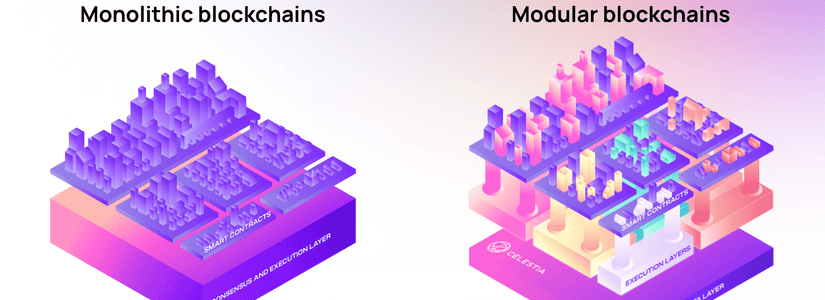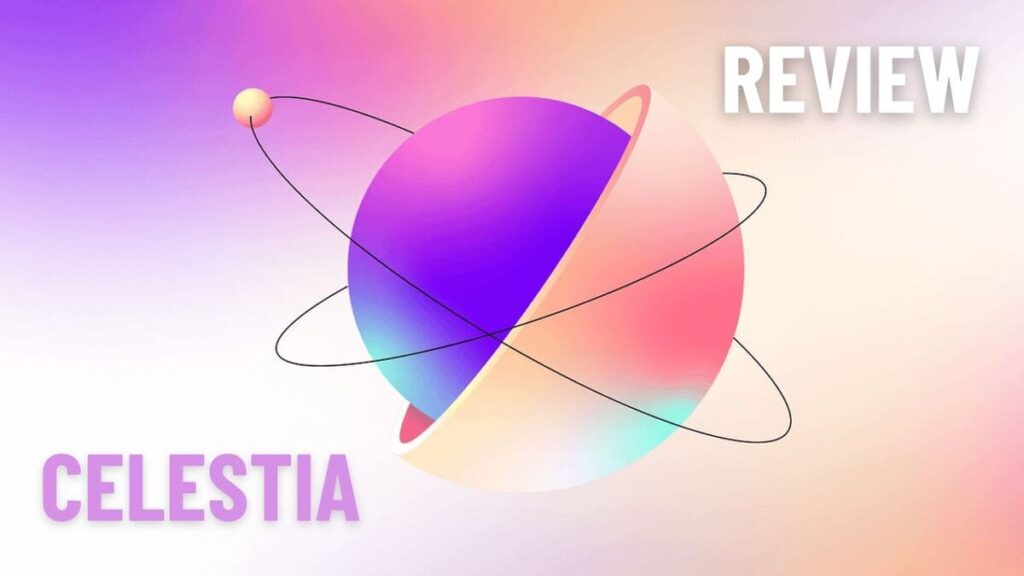Celestia is an innovative proposal that aims to address some of the most pressing challenges in the blockchain industry, such as scalability, flexibility, and decentralization. This modular blockchain offers a specialized yet adaptable approach to meet the needs of both developers and users.
Its design allows for easy integration with other chains, providing tools to create customized blockchains without the need for complex configurations or large initial resources.

What is Celestia?
Celestia is a modular blockchain designed to deaggregate the traditional functions of a blockchain into specialized layers, with the goal of optimizing each one independently. Unlike monolithic blockchains like Ethereum, which combine the consensus and execution layers, Celestia focuses exclusively on the consensus layer and data availability, leaving transaction execution and smart contract operations to other interoperable chains. This separation provides greater flexibility, scalability, and efficiency in resource utilization within the network.
How Does Celestia Work?
Celestia separates the tasks of consensus and execution, which enhances the system’s flexibility and scalability. This separation allows the network to handle different types of transactions and workloads more efficiently. Instead of relying on a single set of nodes to process and validate all operations, Celestia implements a modular architecture that distributes these tasks across various specialized layers. Each layer focuses on a specific function, not only optimizing resources but also making the network more adaptable to new needs and technologies.
Data Availability Layer
This layer is the core of Celestia’s value proposition. Through the use of advanced techniques such as Proof-of-Data-Availability (PoDA), it ensures that all transaction data is accessible and verifiable by network nodes. The erasure coding method splits data into smaller fragments, which are then distributed among the nodes. This enables efficient verification without requiring each node to store the full history of the blockchain.
Data Availability Sampling (DAS) allows light nodes, which do not directly participate in consensus, to validate data availability by simply verifying small random samples of each block. This approach not only improves scalability but also reduces hardware load, democratizing network access.
Consensus Layer
Celestia implements the Tendermint algorithm, a Byzantine Fault Tolerance (BFT)-based solution that prioritizes speed and security. This layer is responsible for ordering transactions and maintaining the integrity of the network against potential attacks. The combination of the Proof of Stake (PoS)-based consensus model and the use of Tendermint enables the network to process transactions with low latency, while also ensuring high reliability and resilience to malicious attacks.
Execution Layer
Unlike monolithic blockchains, Celestia does not natively execute transactions or smart contracts. Instead, this task is delegated to interoperable execution chains, such as rollups and other specialized blockchains. This opens up the possibility of using different execution environments, from virtual machines like Ethereum Virtual Machine (EVM) to more modern technologies like WebAssembly (WASM).
This separation allows developers to choose the execution architecture that best suits their specific needs, providing unprecedented flexibility to create customized applications.
Types of Nodes in Celestia
In its network, Celestia introduces two main types of nodes:
- Light Nodes: These are responsible for validating data availability via DAS and only download headers and block fragments.
- Full Nodes: These store the entire history of the blockchain and actively participate in consensus. Cross-Chain Communication
Cross-Chain Communication
The network uses standards such as Inter-Blockchain Communication (IBC) to improve interaction between different blockchains. This allows data and transactions to flow seamlessly between execution chains and Celestia, creating an interconnected ecosystem.

Challenges for Celestia
Dependence on External Chains
By delegating transaction and smart contract execution, Celestia relies on the effectiveness and stability of other chains to complete the operational cycle, which may introduce external failure points.
Relatively New Model
Modularity is a recent paradigm in blockchain design. While it promises significant advances, it still faces limitations related to mass adoption, tool development, and integration into the current ecosystem.
Complexity for Novice Developers
While the modular system provides flexibility, it can also be intimidating for developers with little blockchain experience, who might find designing and integrating customized solutions challenging.
Market Competition
Other projects, such as Ethereum 2.0 and Polkadot, are also implementing scalable and modular solutions. This could make it difficult for Celestia to differentiate itself or capture a substantial market share.
Interoperability Costs
Although it facilitates cross-chain communication, transaction fees between chains and the resources required to establish such connections may pose a barrier, especially for small projects.

What is the TIA Token and What Does It Do?
Celestia’s native token, known as TIA, plays a central role in the ecosystem, as it is essential for the network’s operation and to encourage active participation from users. This token is designed to perform several key functions:
What Are TIA’s Functions?
- Network Security: TIA is used as the main mechanism in the Proof of Stake (PoS) protocol to ensure the security of the network. Validators must lock a specified amount of TIA as collateral to participate in consensus, and in return, they receive rewards in the form of additional TIA tokens for honestly validating blocks.
- Fee Payment: TIA is also used to pay fees related to publishing data on the Celestia network. This use is crucial to ensure that decentralized applications (dApps) and chains operating on the network can efficiently and securely register their data.
- Incentives for Light and Full Nodes: Although light nodes have lower hardware requirements, full nodes, which store all data and participate in consensus, receive incentives in TIA to maintain network availability and security.
- Governance: TIA enables participation in Celestia’s decentralized governance. Token holders can propose and vote on changes to the protocol, network updates, or the distribution of rewards, ensuring that the project’s direction reflects the community’s priorities.
Considerations for Investing in TIA
The TIA token, like any cryptocurrency, is subject to market volatility, which can result in drastic changes in its value. Additionally, its success largely depends on the level of adoption of Celestia. If the network attracts a significant number of projects and users, the demand for the token will increase, benefiting investors.
However, it faces competition from other networks such as Ethereum, Polkadot, or Cosmos, which also offer scalability and interoperability solutions, potentially slowing Celestia’s adoption and affecting the value of TIA. Lastly, it is crucial to monitor the network’s ability to maintain a sustainable long-term economic model that adequately rewards validators and light nodes while fostering decentralization and avoiding token concentration in the hands of a few actors.
Conclusion
Celestia could be the next step in the evolution of blockchain. With its modular solution, which promises to overcome some of the limitations inherent in traditional architectures, it offers developers unprecedented flexibility to create customized applications and enables the network to scale more efficiently.
However, as a relatively new model, its adoption and overcoming of limitations, such as dependence on external chains and complexity for novice developers, will be determining factors for its long-term success











